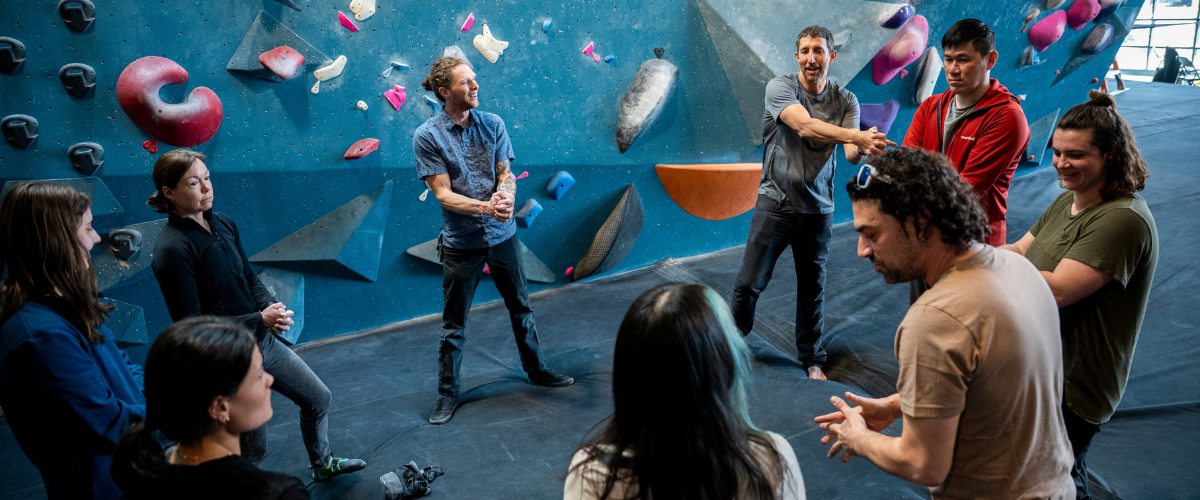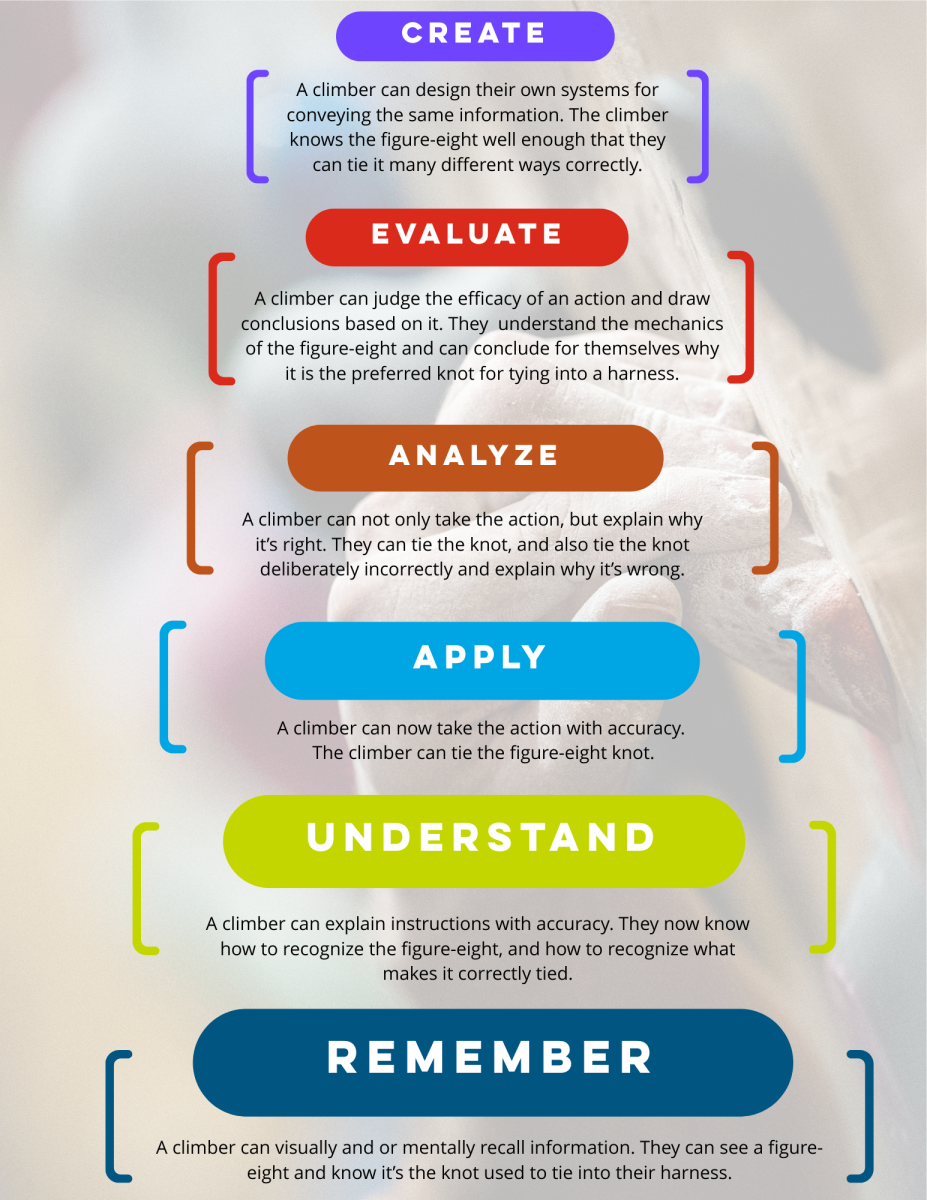Making a Great Indoor Climbing Instructor

The job of an instructor is to deliver the content. A competent instructor provides the necessary instruction of content and skills. A good instructor ensures the required content is delivered in a way that is engaging and that students seem to understand. A great instructor continually assesses how the content is being received and confirms that the content can be applied.
Article At A Glance |
|
Assessment and feedback are key ingredients to learning.
What is Being Offered Matters
There are many principles to keep in mind when instructing; the most important one is that learners are receptive to the information and in a position to engage with the content. It would not be wise to teach a 5.9 climber how to set a 5.12 route when they cannot yet climb that grade successfully. Teaching developmentally appropriate content is a key ingredient to success.
Where the Instruction is Being Offered
Elements within a learning environment can both enhance or distract from the experience. For example, a new climber in a space with a lot of climbers moving around them and routesetting happening off to the right can be overwhelmed, distracting them from the instructor.
How it’s Offered Counts
‘How’ can be divided into two processes:
- How to organize and chunk information for the students
- How to deliver the information to the students
How content is delivered refers to the teaching approach the instructor used to introduce the information. In the past, content was offered in person, and in many cases, the instructor was there to introduce and explain concepts, eventually inviting each participant to practice.
Bloom’s Taxonomy offers a visual representation of the hierarchy of learning objectives. At the lowest level, the student can remember the information.

The student may be able to remember some parts of tying a figure eight after being shown how to tie it. However, they will not be successful tying the knot until they apply the information and tie the knot. This is the third level of Bloom’s Taxonomy where the student can demonstrate skill.
An instructor can ask students to analyze and evaluate the execution of a skill by presenting them with situations or case studies.
Imagine a new rope climber conducting a mock belay check with another course participant. This activity would force the students to reflect on all aspects of the belay system and interactions between the climber and the belay.
Feedback Matters
Feedback impacts the learning process in multiple ways; both by the content itself and the manner it’s delivered. Feedback provided negatively, for example, “that’s not right. Here’s how to do it correctly,” may not be received as well as feedback that starts with a question like, “What can we do to improve this?”
Beginning with a question inspires curiosity and delays any concept of judgment, which can make people respond defensively or make them embarrassed. Open-ended questions, in general, can be constructed to guide the student to the correction needed. Students remember the ideas they problem-solve better than the answers given.
Pro Tip: When a situation presents an immediate danger, an instructor just needs to intervene and manage the risk.
Who the Learner is Matters
In 2012, the potential learners in their late teens and early twenties were born between 1990-1997, falling in the Millennial category. Millennial learners learn best through collaboration and interaction rather than lecture-style learning.
In the CWA CWI Certification Program, this teaching approach is called a social or interpersonal teaching approach. The instructor designs activities that allow students to work together.
Students today are part of Generation Z, born between 2003-2008. While Millennials and Gen Z both adapt well to online learning opportunities, Gen Z learners tend to value independence and flexibility in their personal learning approaches.
This translates to being more adaptable in the delivery of content and the content being delivered, particularly incorporating visual media in an online setting.
Some of the many teaching approaches that can be implemented:
- Use a visual demonstration, explain the content, put the equipment in the learner’s hand, and guide the use of the equipment.
- Presenting learners with a problem to solve or having them work in groups to solve problems as they apply concepts.
Not all students respond as well to all approaches, and then to the second or third step of any particular strategy. Great instructors will look for the most effective approach for the learner and the content.
There is a saying, “those who can’t do, teach.” It makes teaching sound easy, but great teaching is about ensuring that students have a positive experience and can demonstrate their learning.
Getting a diverse group of students to the same outcome in a set time frame is no small feat. The instructor needs to know the content and bring interpersonal skills, communication skills, and patience while paying attention to the student experience. That is a lot.
About The Author
 Heather Reynolds is a licensed kinesiologist, High Five Trainer (Sport, PCHD), CEC Climbing Coach, CWA Climbing Wall Instructor Certification Provider Trainer. She works as a Consultant to the CWA. She blends her knowledge of movement, physiology, and education to develop a multitude of successful climbing programs designed to support and engage youth. Having worked with youth for over 30 years as a recreation instructor, leader and educator, Heather supports the values and expertise available in the High Five Program, bringing quality assurance to youth-based sport and recreation programming.
Heather Reynolds is a licensed kinesiologist, High Five Trainer (Sport, PCHD), CEC Climbing Coach, CWA Climbing Wall Instructor Certification Provider Trainer. She works as a Consultant to the CWA. She blends her knowledge of movement, physiology, and education to develop a multitude of successful climbing programs designed to support and engage youth. Having worked with youth for over 30 years as a recreation instructor, leader and educator, Heather supports the values and expertise available in the High Five Program, bringing quality assurance to youth-based sport and recreation programming.
